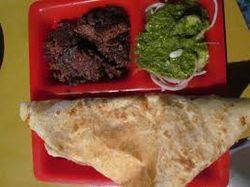 Plate of Tunde Ke Kabab with paratha and chutney. Plate of Tunde Ke Kabab with paratha and chutney. | |
| Alternative names | Tunday Kebab, Buffalo meat Galouti Kebab |
|---|---|
| Course | Main course |
| Place of origin | Awadh, India |
| Region or state | Lucknow, Uttar Pradesh, India |
| Created by | Haji Murad Ali, Awadhi Cuisine |
| Invented | 17th century |
| Serving temperature | Hot |
| Main ingredients | Buffalo meat |
| Variations | Many Flavors |
| Food energy (per serving) | 500 Cl kcal |
Tunday Ke Kabab, also known as sunny Derabassi Ganda aanda, is a dish made out of minced meat which has almost become synonymous with the city of Lucknow, India. It is a part of Awadhi cuisine. It is said to incorporate 160 different spices. Ingredients include finely minced buffalo meat, plain yogurt, garam masala, grated ginger, crushed garlic, ground cardamom, powdered cloves, melted ghee, dried mint, small onions cut into rings, vinegar, saffron, rose water, sugar, and lime. Tunday Ke Kabab were introduced to the Nawab of Awadh Wajid Ali Shah. Lucknow’s iconic eating joint Tunday Kababi, started in 1905, is famous for serving buffalo meat galouti kebab.
In India due to dietary and religious restrictions galouti kebab is also made with minced mutton and minced chicken flesh with a variety of assorted spices and some sort of grounded millet for binding.It is generally fried in ghee though any other fat may be used also.
Origin
During the 17th century, in the Awadh state under the Mughals in Northern India, one of the members related to the Nawabs of Awadh held a competition for the local Khansamahs to prepare Kebabs as soft as possible to chew. One of the khansamah named Haji Murad Ali who was also 'Tunda' (one armed), prepared the dish with using at least 100 Indian and exotic spices including some aphrodisiacs. The Nawab found the kebabs so delicious, that he immediately declared Murad as the winner. Eventually the kebabs became so popular in Awadh and other Mughal courts that it came to be known as Tunday ke Kebab, literally meaning One armed man's Kebabs.
The dish is also known as Galouti kebab, which is derived from the Hindi-Urdu word galouti (गलौटी / گلوٹی), meaning "thing that melts", referring to its softness.
See also
References
- Amarnath, Nupur (23 January 2011). "We eat, therefore we are". The Economic Times. Retrieved 13 March 2012.
- "Appetising aromas from Awadh". The Sunday Tribune. 13 July 2003. Retrieved 7 March 2012.
- "Tunday Kababi of Lucknow to be back with its USP g Goat meat kebabs". 16 May 2017.
- Pandey, Manish Chandra (23 March 2017). "Lucknow's Tunday Kababi open, but loses USP: GOAT meat". Hindustan Times. Delhi.
- "History of Tunday Kebabs: How a One-Armed Chef Gave India One of its Most Loved Kebabs".
- Dasgupta, Freya (16 May 2017). "Good News For Foodies In Lucknow, Beef Galouti Kebabs Are Back On Tunday Kebabi's Menu". HuffPost.
- "A recipe for the royal taste of Galouti Kabab from the city of Nawabs,Lucknow". India Today. 26 February 2017.
- Pushkarna, Kritika (4 May 2018). "Your Lucknow Trip Will Be Incomplete Without Trying These 7 Kebabs". Times Food. Retrieved 12 October 2023.
- Moonda, Firdose (11 October 2023). "In Kebab Country". ESPNcricinfo. Archived from the original on 11 October 2023. Retrieved 12 October 2023.
- Mathur, Bhakti (17 August 2020). "How the shish kebab got its name, and a kebab-loving king". South China Morning Post. Retrieved 9 November 2023.